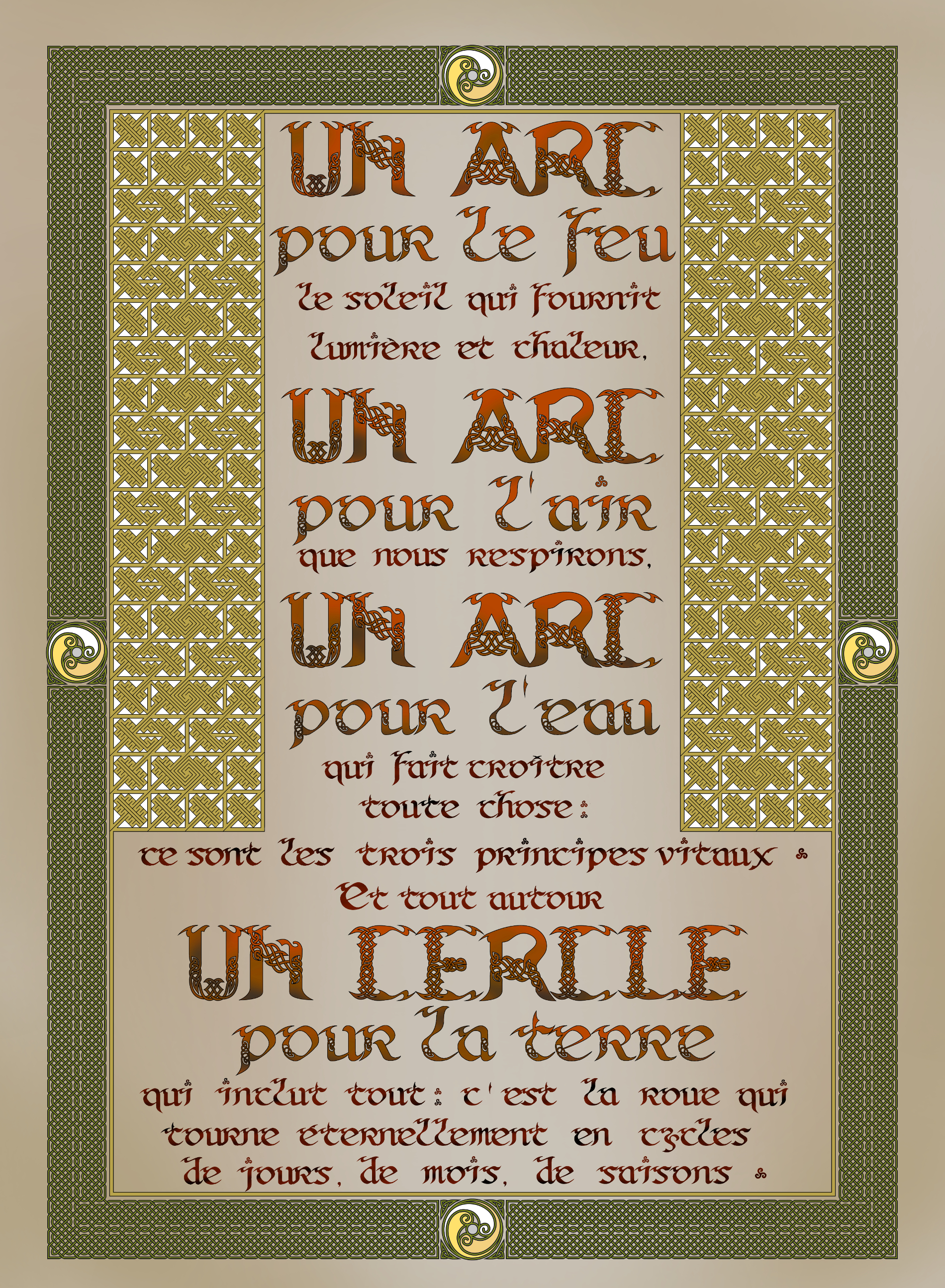fol. 13r
Un arc pour le feu,
le soleil qui fournit lumière et chaleur,
un arc pour l'air que nous respirons,
un arc pour l'eau
qui fait croître toute chose,
(ce sont les trois principes vitaux),
et tout autour:
un cercle pour la terre qui inclut tout:
c'est la roue qui tourne éternellement en cycles de jours, de mois, de saisons.
On dit que le triskel à trois spirales était à l'origine un symbole du soleil.
Ou peut-être juste une représentation stylisée d'une feuille de trèfle...
Il existe de nombreuses explications à la signification des trois arcs du triskel.
Par exemple, ils peuvent représenter: Lug, Dagda et Ogmios, les trois dieux celtiques les plus importants; passé, présent et futur; naissance, vie et mort; jeunesse, maturité et vieillesse; corps, esprit et âme; mère, père, enfant; thèse, antithèse, synthèse; pensée, parole et acte; le sommeil, le rêve et l'éveil; vierge, mère et vieille femme; père, fils et esprit saint.
Ainsi, à peu près toutes les idées qui apparaissent dans un groupe de trois peuvent être représentées par le triskel.
L'explication la plus courante est que les trois arcs représentent les éléments Eau, Terre et Feu. Le point central du triskel signifierait alors Air.
Ou ils représentent: la Terre, l'Eau et le Ciel.
Ou encore:
"Certains bretons disent que le triskel représente l'eau, l'air et le feu, la terre étant au centre."
(Source: Bien vivre à Lannédern - Bevañ mat e Lannedern - La période celtique )
Le triskel avec trois arcs simples dans un cercle, comme dessiné par Dahut dans le sable, est identique au gankyil bouddhiste, symbole qui représente l'unité et l'interdépendance. Cela m'a semblé approprié dans le contexte de l'argumentation de Dahut sur les trois principes vitaux.
Une miette d'information insolite: le même symbole, mais avec des trous aux trois centres des arcs, se révèle également être un emblème de la communauté SM.
fol. 13r
An arc for fire,
the sun which provides light and heat,
an arc for the air we breathe,
an arc for water,
which makes everything grow,
(these are the three vital principles),
and all around:
a circle for the earth that includes everything:
it is the wheel that turns eternally in cycles of days, months, seasons.
It is said that the triskel with three spirals was originally a symbol of the sun.
Or maybe just a stylized representation of a clover leaf...
There are many explanations for the meaning of the three arcs of the triskel.
For example, they can represent: Lug, Dagda and Ogmios, the three most important Celtic gods; past, present and future; birth, life and death; youth, maturity and old age; body, mind and soul; mother, father, child; thesis, antithesis, synthesis; thought, word and deed; sleep, dream and wakefulness; virgin, mother and old woman; father, son and holy spirit.
So pretty much any idea that appears in a group of three can be represented by the triskelion.
The most common explanation is that the three arcs represent the elements Water, Earth and Fire. The central point of the triskel would then mean Air.
Or they represent: Earth, Water and Sky.
Or again:
"Some Bretons say that the triskel represents water, air and fire, the earth being at the center."
(French source: Bien vivre à Lannédern - Bevañ mat e Lannedern - La période celtique ) < br>
The triskel with three simple arcs in a circle, as drawn by Dahut in the sand, is identical to the Buddhist gankyil, a symbol which represents unity and interdependence. This seemed appropriate to me in the context of Dahut's argument on the three vital principles.
A crumb of unusual knowledge: the same symbol, but with holes at the three centers of the arcs, also turns out to be an emblem of the SM community.
Cliquez l'image pour une meilleure qualité.
Click on the picture for a better quality.

